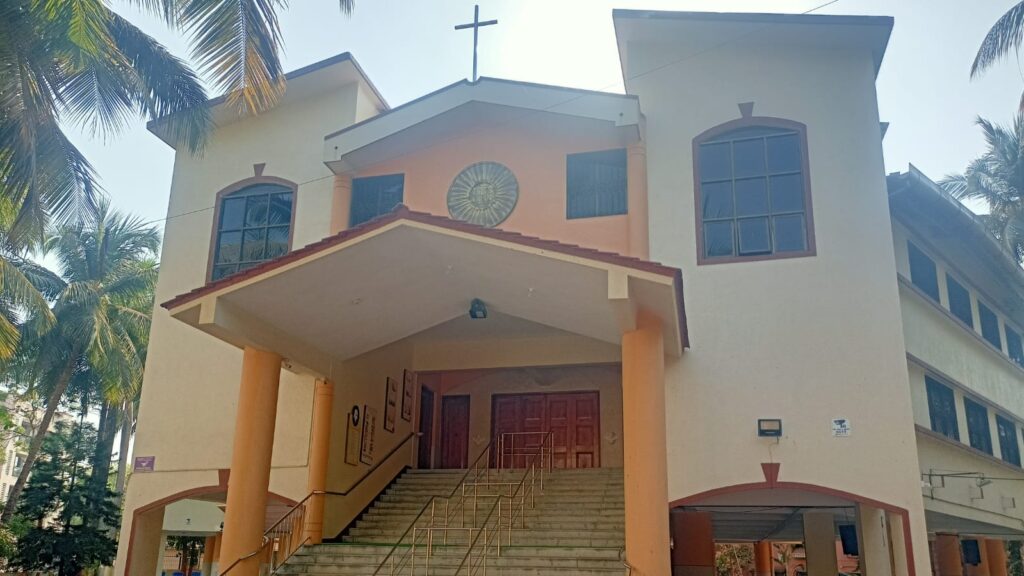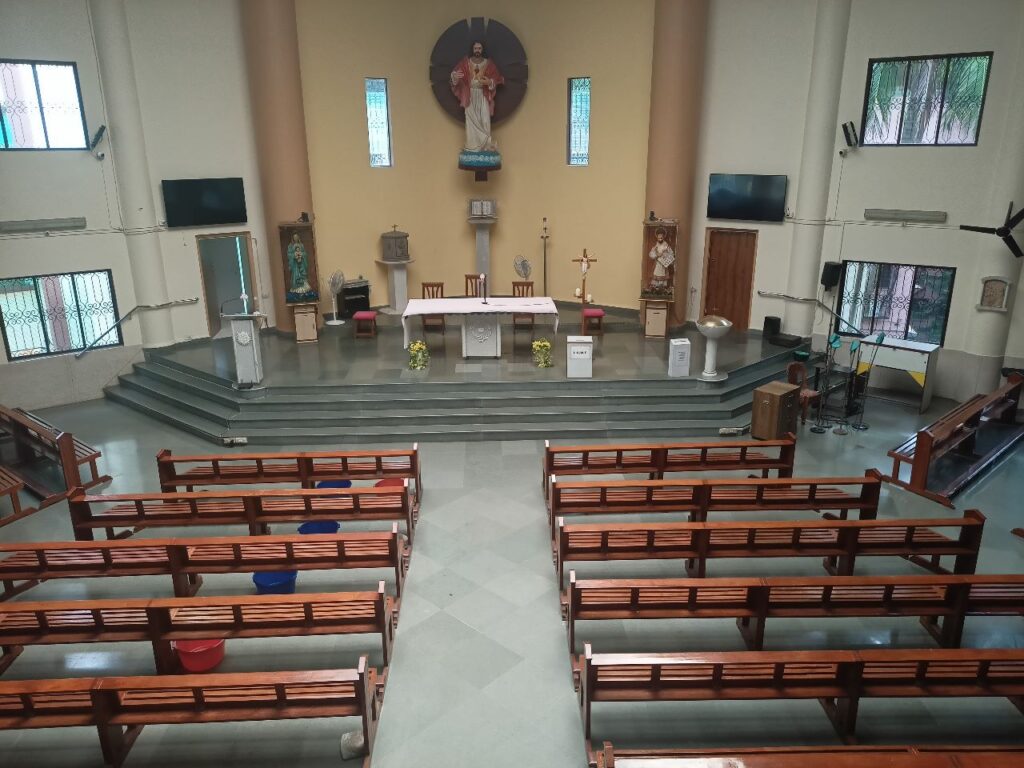History of St. Ignatius Loyola Church
This parish started as a new zone of St. Michael ‘s Church, Manickpur. Most of the people forming this parish migrated from Mumbai. Initially, they had to attend Mass in Marathi at St. Michael’s Church, Manickpur. As they found it difficult to follow Marathi, they asked for a separate Mass Centre in this area. It was in the year 1988, when the young and the old both joined hands and began the search for a plot of land to build the church. In 1991 they expressed their difficulties to the Parish Priest of St. Michael’s Church, Fr. Joe Pithekar. He understood their difficulties and made arrangements to have masses in this area in English. That year the Christmas mid-night Mass was at Dhuri Complex, Om Nagar and there was an attendance of about 1,500 parishioners.
That same year, at a junction off Ambadi Road, a small cross with a shed was built with the name of Ambadi Cross. It was inaugurated by Fr. Rudy Fernandez and since then Masses were celebrated every Sunday. Sunshine or rainfall, the Eucharist continued to be celebrated at the Ambadi Cross and even Bishop Thomas Dabre was glad to celebrate the Eucharist for these Catholics. Later the Sisters of St. Anne offered their premises and the evening masses were held in the open whilst the morning masses were held in the compound of the old St. Francis School and later in the new school building, thanks to the kindness and generosity of Mr. And Mrs. Augustine Pinto.

At that time Vasai belonged to the Archdiocese of Bombay and the Cardinal requested the Jesuits of Manickpur to start a new parish at Ambadi Road. Fr. Tony Jurschik was appointed in charge and in 1995 he found a flat belonging to a couple from Bandra and not used and they offered it to him. Being quite close to Ambadi Cross it was convenient. When the new parish started, the Bombay Archdiocese asked him what name he wanted and he chose “St. Ignatius Loyola”. At that time he applied for registration of a Trust with the name of Snehanjali Samaj Kendra to the Asst. Charity
Commissioner of Thane and this was granted on 22.06.1995 with the number D-79 (Thane). Since the number of parishioners was growing Fr. Tony asked the Provincial for help and Fr. Augustine Silveira joined this parish in June 1996. It was recognized as a parish without Church. Both Tony and Augustine tried to get a plot to build the Church and for this they went around collecting funds for the same. In June 1999 Tony was transferred to St. Gonzalo Garcia Parish and Fr. Cedric Rebello was appointed Parish Priest by the Bishop of Vasai. This new Diocese had been inaugurated in 1998. In June 2000 Fr. Simon Fernandes was made P.P. and he managed to purchase a plot in the year 2001. The foundation stone was laid on January 1, 2003, the Feast of Mary, the Mother of God.
In June 2002, Fr. Joe D’Abreo was appointed PP and he took the responsibility of building the Church and with tremendous efforts got money for it. Fr. Bernard D’Souza joined him as Asst. PP. Within a span of three years with the hard work of the Parishioners and the overwhelming generosity of our Benefactors, the Church of St. Ignatius Loyola became a reality.
As work progressed, the Parish team moved to the new residence “Xavier House” by the side of the Church in January 2006. At that time the members were: Fr. Joe D’Abreo (P.P.), Fr. Vincent D’Souza and Fr. Kenneth D’Souza. At the suggestion of a Parishioner, the Church is painted with a golden yellow representing the 7000 golden hearts of Loyola Parish and the brick red, a reminder of the immense sacrifices our Parishioners and Benefactors have made for this our beautiful Church. The new Church was completed in April 2006 and was consecrated by Bishop Thomas Dabre on Easter Sunday 16th April 2006.

The Church Building is unique
The church itself is unique, situated as it is on the first floor. This must be one of the very few churches anywhere, if not the only one of its kind, with a high row of steps leading up to it. Over the main entrance is the parish emblem with a huge stainless steel cross at the top. The church itself is hexagonal in shape. A huge wooden cross bearing a larger than life image of the Sacred Heart of Jesus forms the backdrop on the wall just above the tabernacle. The altar is a simple long table of marble to the left of which is the baptismal font and to the right the lectern both of marble.
The benches in the church can accommodate a further 500 people. Pillars around the sides of the church support a balcony which can accommodate a further 250 people and the choir. These pillars have the Stations of the Cross on them in marble and figures in fibre glass. The roof has a spider web-like structure of polycarbonate at the centre which allows the sunlight in during the day and zinc allium sheeting on the outer half. Two doors on either side of the altar lead to the sacristy behind. To enable the elderly to get to the church, a lift has been provided which will also be of great help to those wishing to visit the parish house. The under croft on the ground floor has huge pillars supporting the church above and can be used for cultural and other functions. To the left of the main entrance to the church is the grotto of Our Lady.
The compound walls are dotted with palm trees, bougainvillaea’s and X’Mas trees, all in full bloom. The church itself is painted a golden yellow and brick red representing the 7000 golden hearts of our parishioners and a reminder of the sacrifices of our parishioners and benefactors who have helped in making this “Dream Church” a reality.
